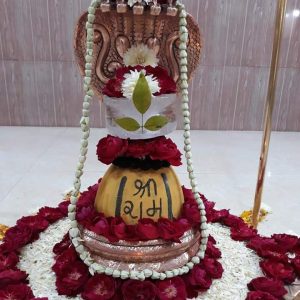This hymn is from the Kaumārikakhaṇḍa of the Māheśvarakhaṇḍa of the Skanda Purāṇa. It gives the mantras of the 5 faces of Śiva(known as the pañca(five) brahma mantras/vaktra mantras) and the tryāmbaka mantra in a form which everyone can recite(and also the pañcākṣarī in a form where everyone can uncontroversially recount it-context for this last bit is that apparently some āgamas recommend adding either the praṇava or Śākta praṇava to the pañcākṣarī for vīrya janana of the mantra,and what is to be added and allowed to whom added,or whether it really needs to be is a matter to be best learned from paramparā and is upto one’s own guru=one’s own paramparā is the final pramāṇa in these matters).
The sage Kālabhīti’the son of Māṃṭi and his wife Citralekhā who gained this epithet because he refused to come out of his mothers womb due to the fear of Kāla and took birth only after the persuation of Śiva and who became a Pāśupata and did lakhs of japas near Stambhatīrtha(Khambat) and under a Bilva tree. The subsequent description of what happened will be very interesting for any sādhaka:
nivṛtto nādidūre’tha vilvavṛkṣa dadarśa saḥ।
dṛṣṭvā taṃ tasya cādhastāllakṣamekaṃjajapā saḥ॥
japastasya viprasya indriyānī layaṃ yayuḥ।
kevalaṃparamānandasvarūpo’sāvabhūtkṣaṇāt॥
His own recollection of his mental state
nāyaṃ mama mahānando vārānasyām na naimiṣe।
na prabhāse na kedāre na cāpyamarakaṇṭake॥
nirvikārānisvacchāni gaṅgābhāṃsīvakhānime॥
bhūteṣu paramāprītistrijagaddyotate sphuṭaṃ।
dharmamekaṃ paraṃ mahyaṃ cetaścāpyavagacchati॥
After this follows an exchange by an unknown stranger who comes to test the sage Kālabhīti on the ritual purity of his observances and after that’a liṅga manifested from under the bilva tree and he sings the stotra which contains the essence of the 5 face mantras/brahma mantras of Śiva’the Tryāmbaka mantra and the holy pañcākṣara. Mahādeva then appears from the just appeared liṅga and then states that he had filled the lake whose waters the sage had initially refused to drink and he was the same one who had appeared in the form of a man with unknown antecedents and blesser the reciter of this hymn with the fruit of reciting these seven mantras. That place became sacred as the temple of Mahākāla on the bank of the lake Mādalā.
Now I am listing the stotra along with the phalaśruti(explanations are in normal brackets and are obviously not to be recited,just for understanding). Ātmaka=of the nature of,for those whose Sanskrit is poor. Anyone who has not learned the corresponding vaidika mantras from the mouth of a guru(especially the brahma mantras and the tryambaka mantra) can recite the stotra or corresponding ślokas and get the benefit of the mantra.
[Kālabhīti uvāca]
pāpasya kālaṃ bhavapaṅkapālaṃ kalākalaṁ kālamārgasya kālam।
devaṃ mahākālamahaṃ prapadye śrīkālakaṇṭharūpaṃ bhavakālarūpam॥
īśānavaktraṃ praṇamāmi tvāhaṃ stauti śrutiḥ sarvavidyeśvarastvaṃ।
bhūteśvarastvaṃ prapitā mahastvaṃ tasmai namaste’stu maheśvarāya॥ (Īśāna vaktramantrātmaka śloka)
yaṃ stauti vedastamahaṃ prapadye tatpuruṣasaṃjñaṃ śaraṇaṃ dvitīyam।
tvāṃ vidmahe tacca nastvaṃ pradehi śrīrudra devadevaśa namonamaste॥ (Tatpuruṣa vaktramantrātmaka śloka)
aghoravaktraṃ tritayaṃ prapadye atharvajuṣṭaṃ tava rūpakāṇi।
aghoraghorāṇi ca ghoraghorāṇyahaṃ sadā naumi bhūtāni tubhyam॥ (Aghora vaktramantrātmaka śloka)
caturthavaktraṃ ca sadā prapadye sadyobhijātāya namonamaste।
bhavebhavenādibhavo bhavasva bhavodbhavo māṃ śiva tatratatra॥ (Sadyojāta vaktramantrātmaka śloka)
namo’stu te vāmadevāya jyeṣṭharudrāya kālāya kalāvikariṇe।
balaṃkarāyāpi balapramāthine bhūtāni haṃtre ca manonmanāya॥ (Vāmadeva vaktramantrātmaka śloka)
triyaṃbakaṃ tvāṃ ca yajāmahe vayaṃ supuṇyagandhaiḥ śivapuṣṭivardhanam।
urvārukaṃ pakvamivograbaṃdhanādrakṣasva māṃ tryaṃbakaṃ mṛtyumārgāt॥ (Tryambaka mantrātmaka śloka)
ṣaḍakṣaraṃ mantravaraṃ taveśa japaṃti ye munayo vītarāgāḥ।
teṣāṃ prasanno’si japāmahe tvoṃkārapūrvaṃ ca namaḥ śivāya॥ (Oṃkārayukta śivapañcākṣaramantrātmaka śloka)
phalaśruti
[Mahādeva uvāca]
saptamantrarahasyaṃ ca yatkṛtaṃ stavataṃ mama।
anena paṭhyamānena saptamantraphalaṃ labhet॥
The stotra is presented below with Devanagari:
[कालभीति उवाच]
पापस्य कालं भवपङ्कपालं कलाकलं कालमार्गस्य कालम्।
देवं महाकालमहं प्रपद्ये श्रीकालकण्ठरूपं भवकालरूपम्॥
ईशानवक्त्रं प्रणमामि त्वाहं स्तौति श्रुतिः सर्वविद्येश्वरस्त्वं।
भूतेश्वरस्त्वं प्रपिता महस्त्वं तस्मै नमस्तेऽस्तु महेश्वराय॥ (ईशान वक्त्रमन्त्रात्मक श्लोक)
यं स्तौति वेदस्तमहं प्रपद्ये तत्पुरुषसंज्ञं शरणं द्वितीयम्।
त्वां विद्महे तच्च नस्त्वं प्रदेहि श्रीरुद्र देवदेवश नमोनमस्ते॥ (तत्पुरुष वक्त्रमन्त्रात्मक श्लोक)
अघोरवक्त्रं त्रितयं प्रपद्ये अथर्वजुष्टं तव रूपकाणि।
अघोरघोराणि च घोरघोराण्यहं सदा नौमि भूतानि तुभ्यम्॥ (अघोर वक्त्रमन्त्रात्मक श्लोक)
चतुर्थवक्त्रं च सदा प्रपद्ये सद्योभिजाताय नमोनमस्ते।
भवेभवेनादिभवो भवस्व भवोद्भवो मां शिव तत्रतत्र॥ (सद्योजात वक्त्रमन्त्रात्मक श्लोक)
नमोऽस्तु ते वामदेवाय ज्येष्ठरुद्राय कालाय कलाविकरिणे।
बलंकरायापि बलप्रमाथिने भूतानि हंत्रे च मनोन्मनाय॥ (वामदेव वक्त्रमन्त्रात्मक श्लोक)
त्रियंबकं त्वां च यजामहे वयं सुपुण्यगन्धैः शिवपुष्टिवर्धनम्।
उर्वारुकं पक्वमिवोग्रबंधनाद्रक्षस्व मां त्र्यंबकं मृत्युमार्गात्॥ (त्र्यम्बक मन्त्रात्मक श्लोक)
षडक्षरं मन्त्रवरं तवेश जपंति ये मुनयो वीतरागाः।
तेषां प्रसन्नोऽसि जपामहे तम् त्वोंकारपूर्वम् च नमः शिवाय॥ (ॐकारयुक्त शिवपञ्चाक्षरमन्त्रात्मक श्लोक)
[महादेव उवाच]
सप्तमन्त्ररहस्यं च यत्कृतं स्तवतं मम।
अनेन पठ्यमानेन सप्तमन्त्रफलं लभेत्॥
This Stambha tīrtha is currently located at Vasad,Gujarat with attempted revivers also.
